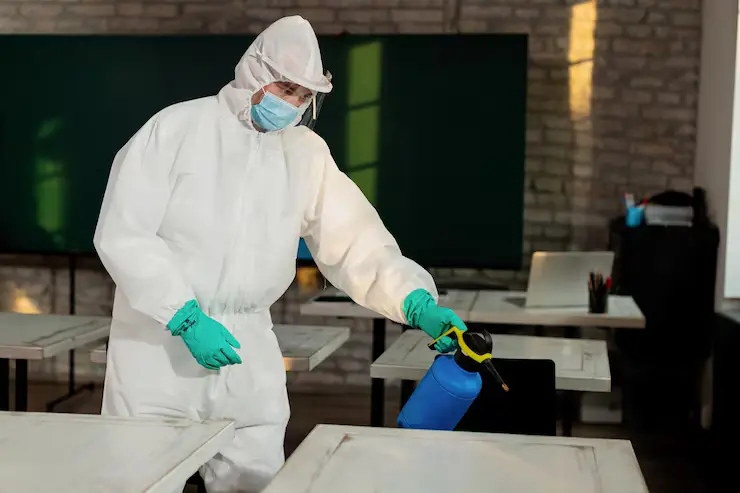✨ Quickly Summarize This Post Using AI
Environmentally safe pest control is gaining attention as more homeowners are searching for non-toxic, sustainable solutions to control pests without harming their fitness or the environment. In this guide, you may discover ways to practice green pest management strategies effectively, recognize their blessings, and discover herbal alternatives that can be secure for humans, pets, and the planet.
Why Choose Environmentally Safe Pest Control?
Traditional pest control techniques often depend on chemical-laden pesticides that can pollute indoor air, harm useful insects, and contaminate soil and water. Environmentally pleasant pest control strategies aim to eliminate pests while retaining environmental stability.
Benefits of Eco-Friendly Pest Management:
- Safer for children and pets
- Reduces exposure to harmful toxins
- Supports long-term pest prevention
- Protects pollinators like bees and butterflies
- Improves indoor air quality
1. Start with Prevention: The First Step to Eco-Safe Pest Control
Preventing pests is the most sustainable and cost-effective approach. Here’s how to get started:

Seal Entry Points
Inspect your home for cracks, crevices, and gaps around windows, doors, and vents. Seal these with caulk or weatherstripping to block pest access.
Eliminate Food and Water Sources
- Keep counters and floors free from crumbs.
- Store food in airtight containers.
- Fix leaky pipes and remove standing water.
Declutter and Maintain Your Yard
- Trim overgrown shrubs and trees away from the house.
- Clean out gutters regularly.
- Store firewood away from your home’s foundation.
2. Use Natural and Non-Toxic Remedies
There are many eco-friendly insect control solutions crafted from natural substances that paint just as effectively as artificial chemical substances.
DIY Natural Pest Repellents
- Vinegar Spray: Repels ants, flies, and some spiders.
- Garlic and Chili Spray: Works against aphids and caterpillars in gardens.
- Essential Oils (Peppermint, Lavender, Eucalyptus): Effective for mosquitoes and rodents.
Eco-Friendly Pesticide Examples
- Neem Oil: Derived from the neem tree, it disrupts the reproductive cycle of many insects.
- Diatomaceous Earth: A natural powder that dehydrates insects upon contact.
- Insecticidal Soap: Made from natural fatty acids, ideal for soft-bodied pests like aphids.
✅ Pro Tip: Always test any DIY spray on a small area of plants or surfaces before widespread use.
3. Use Biological Controls
Biological pest control involves using other organisms to keep pest populations under control.
- Ladybugs feed on aphids and other harmful insects.
- Nematodes are microscopic worms that target soil-dwelling pests.
- Bacillus thuringiensis (Bt): A bacterium used to target caterpillars and mosquito larvae.
These natural predators offer a sustainable and balanced way to manage pests in your garden.
4. Apply Environmentally Friendly Pesticides for Crops
If you’re a gardener or grow your vegetables, consider these plant-safe and eco-friendly options:
- Companion Planting: Planting basil with tomatoes or marigolds around vegetables helps repel harmful insects.
- Crop Rotation Prevents the buildup of soil-borne pests and diseases.
- Homemade Compost Tea: Strengthens plant immunity and deters pests naturally.
5. Professional Eco-Friendly Pest Control Services
When DIY solutions aren’t enough, look for professionals who offer eco-friendly pest management services.
Ask about:
- Green or organic pest treatment plans
- Certification by organizations like GreenPro or EcoWise
- Use of Integrated Pest Management (IPM) practices
Real-Life Example: Susan’s Pet-Safe Ant Problem
Susan, a homeowner in Austin, Texas, observed ants invading her kitchen. Concerned about her two dogs, she averted chemical sprays. Instead, she used a mixture of peppermint oil and vinegar spray near access factors and positioned diatomaceous earth around baseboards. Within a week, the ant interest dropped notably, and her pets stayed secure.
Pros & Cons of Environmentally Safe Pest Control
Pros:
- Safe for humans, pets, and wildlife
- Non-toxic and biodegradable options
- Reduces chemical resistance in pests
- Promotes long-term pest prevention
Cons:
- May require more frequent application
- Results may take longer than chemical pesticides
- DIY methods need consistency
🛋️ Bonus Read: Want to harmonize your home’s energy while keeping pests out? Check out 15 Easy Steps To Feng Shui Living Room Arrangement in 2025 for more healthy home tips.
FAQs
1. What is the most environmentally friendly pesticide?
Neem oil, diatomaceous earth, and Bt are among the safest, non-toxic pesticides widely used for eco-friendly pest control.
2. What’s the best natural pest control?
The best natural pest control depends on the pest type, but prevention, essential oils, and biological controls are highly effective across many pest categories.
3. Is pest control safe for the environment?
Traditional pest control may harm the environment, but environmentally safe pest control methods pose minimal risk when used correctly.
4. What is a sustainable approach to pest control?
A sustainable approach includes Integrated Pest Management (IPM), biological controls, and natural repellents that maintain ecological balance without chemical overuse.
Final Thoughts
Using environmentally safe pest control at home is a smart, responsible choice for families who care about their fitness and their surroundings. With a mixture of preventive measures, natural repellents, biological controls, and professional services when needed, you can enjoy a pest-free area without the downsides of toxic chemicals.

